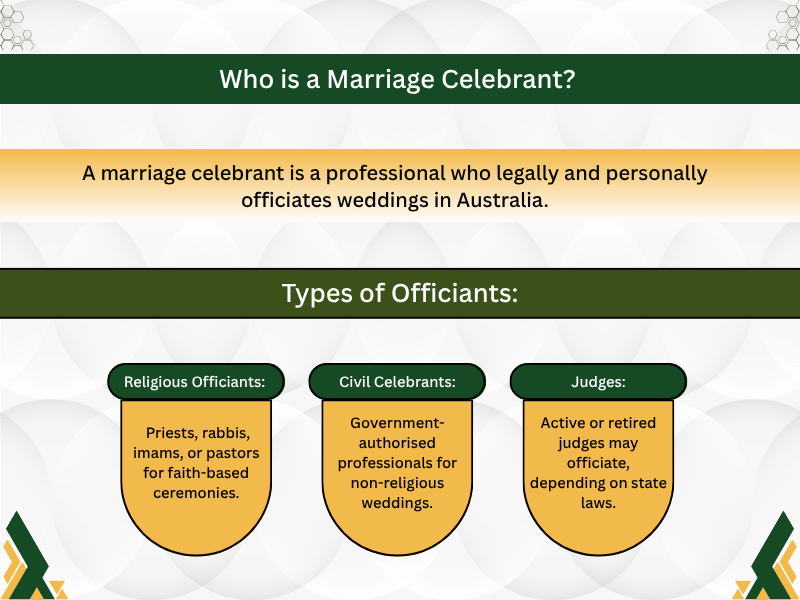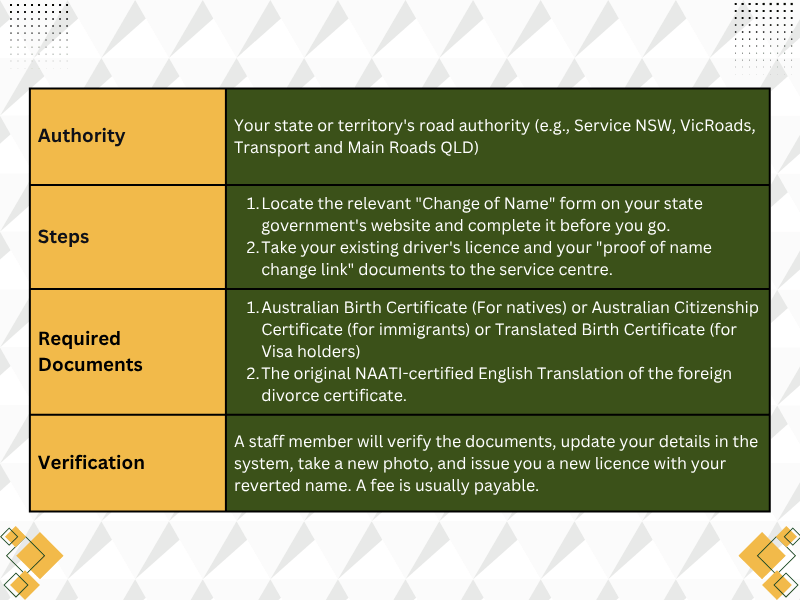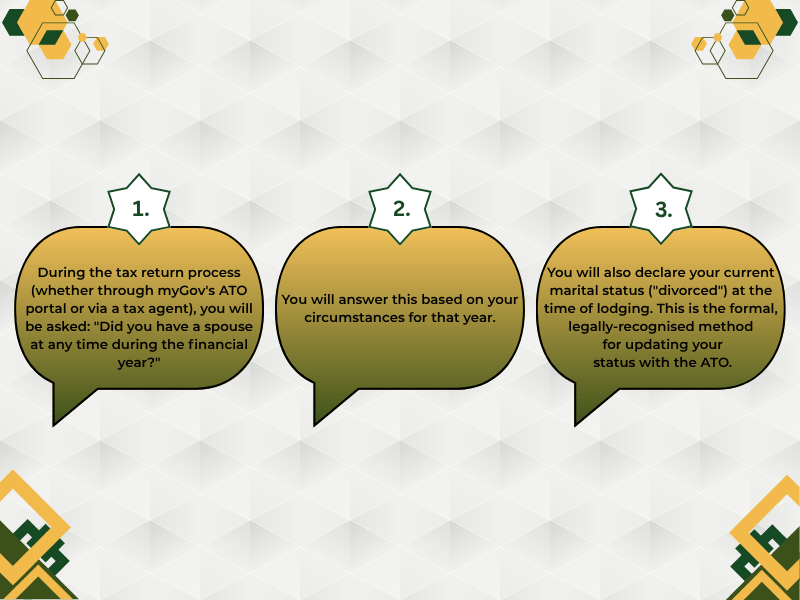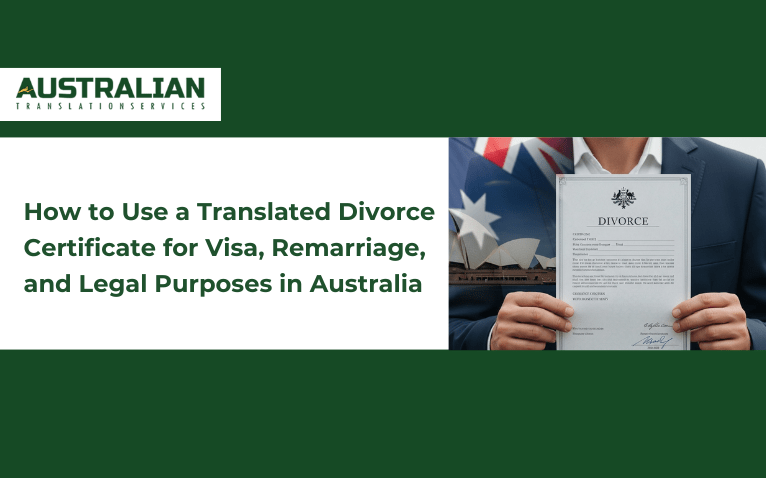Getting your divorce certificate translated is a significant step. However, it is just the beginning of the next chapter. This newly translated document opens the way to a new visa, the freedom to remarry, or the ability to finalise important legal and financial matters.
But are you fully aware of how to use it for different purposes in Australia? This guide is entirely dedicated to this topic.
We will walk you through exactly how to use a translated divorce certificate for visa, remarriage, and legal purposes in Australia, ensuring you are well-prepared for what comes next.
Considerations Before Using a Translated Certificate in Australia
1. Does it contain all the necessary information and is formatted correctly?
2. Is your document translated professionally by a NAATI translation service?
Let’s explore these key considerations in detail:
First, What Information Should Be on the Translated Certificate?
A compliant translation must be a complete, word-for-word replica of the original divorce decree. This includes translating:
- Full Names: The names of both parties must be translated exactly as they appear on the original certificate and must match the names on your other identification documents, such as your passport.
- Dates and Locations: The date of the marriage, the date of the divorce, and the location where the divorce was granted are critical details.
- Court and Case Details: The name of the court that issued the divorce, along with any specific case or file numbers, must be included.
- Seals, Stamps, and Signatures: Every seal, stamp, signature, and annotation on the original certificate must be described and translated. For example, the translation might include a description in brackets, such as “[Signature of court clerk]” or “[Official seal of the Family Court of City]”.
Second, Is It NAATI-certified?
Crucially, the translation of any important document must be accompanied by a certification statement from the translator to have a valid NAATI accreditation status in Australia. A divorce certificate is no exception here.
Why NAATI Certification is Essential?
The Obligatory Requirement: The Department of Home Affairs will only accept translations completed by a translator accredited by the National Accreditation Authority for Translators and Interpreters (NAATI). The translator’s certification, including their NAATI ID and stamp, must be clearly visible on the document.
Furthermore, a professionally translated document is precise and accurately reflects the original certificate.
Additionally, since the entire translation process is handled with meticulous care by experts, your certified translated document is accepted by authorities without question.
Now, let’s explore different uses of divorce certificate translation:
How Do I Use My Translated Divorce Certificate for an Australian Visa?

The Department of Home Affairs requires documents to be provided in a specific, compliant manner. A misstep here can lead to significant delays.
Here is a proper breakdown of the correct protocol for using a translated certificate for visa applications through the official ImmiAccount portal:
Step 1: Get Your NAATI Divorce Translation for Immigration
As per the obligatory rules, the NAATI translation of divorce certificate is the first step. A professional translation agency like AustralianTranslationServices can help you out!
Step 2: Prepare High-Quality Digital Copies
You will need clear digital scans of two separate documents:
- The original divorce certificate (in its original language).
- The complete, multi-page NAATI-certified translation.
Step 3: Scan requirements
Scan in full colour to ensure all stamps and seals are clearly visible. Here are some tips:
- Ensure the scan is high-resolution, not blurry, and that no part of the document is cut off.
- Your file format must be in PDF (the universally preferred format).
Step 4: Name Your Files Logically
A case officer reviews hundreds of documents. Make their job easier and your application clearer by naming your files descriptively. This reduces the risk of human error. Use a convention like:
- Divorce_Certificate_Original_[Your_Name].pdf
- Divorce_Certificate_Translation_NAATI_[Your_Name].pdf
Step 5: Upload the Documents to Your ImmiAccount
Inside your visa application on the ImmiAccount portal, you will see sections that require supporting evidence.
- Go to the relevant category. This is typically labelled “Relationship evidence,” “Evidence of previous relationships,” or “Identity documents.”
- Upload both files (the original and the translation) to the same section.
NOTE: Do not upload the original in one part of the application and the translation in another. They must be submitted as a pair.
Final Step: Review the Uploaded Documents
Before you finalise and submit your application, double-check your work.
- Click on the uploaded files to ensure they open correctly and are the right documents.
- Confirm that the details on your translated certificate (names, dates) are 100% consistent with the information you have manually entered into the visa application forms.
This final check can save you from a “careless mistake” that could delay your visa for months.
How Can I Use a Translated Divorce Certificate to Remarry in Australia?
If you plan to remarry in Australia, you must legally prove that your previous marriage registration was nullified.
In this case, if your divorce certificate was issued in a different country and in a language other than English, a correctly translated overseas divorce certificate is required for the remarriage documentation process in Australia to fulfil this legal obligation.
The remarriage documentation process in Australia mandates this formality before a new marriage can be solemnised.
To proceed, here are some steps to follow:
Step 1: Engage an Authorised Marriage Celebrant
Your first step is to choose and book an authorised marriage celebrant. During your initial discussions, inform them that you will be using an overseas divorce certificate. They will confirm their requirements and help you with your further proceedings.

Step 2: Complete the Notice of Intended Marriage (NOIM)
The NOIM is a legal form that formally declares your intent to marry. You must complete this form and lodge it with your celebrant at least one month before your intended wedding date.

Step 3: The Official Lodgement Meeting with Your Celebrant
This meeting is where you legally lodge the NOIM and have your documents verified. It’s crucial to bring the correct papers.
Do I Need the Original Documents?
Yes! Photocopies are not sufficient for this legal verification. For official verification, you must bring the hard copies of your
- Original Divorce Certificate,
- Original NAATI-Certified English Translation
- Original Documents of IDs (such as your passport or birth certificate)
Step 4: The Celebrant’s Verification Process
During the lodgement meeting, your celebrant will perform a careful verification. They will:

This meticulous check is a legal requirement for the celebrant to ensure the marriage can proceed lawfully.
Step 5: Successful Lodgement
Once the celebrant has successfully verified your original divorce certificate and its NAATI translation, they will officially accept and sign the NOIM.
This completes the legal requirement, and the one-month minimum waiting period begins.
From this point forward, your translated document has served its purpose, legally proving your eligibility to remarry in Australia.
For those who are just beginning this journey and are unsure of the first steps, understanding How to obtain divorce certificate in Australia is the foundational starting point.
What Other Legal Uses Does My Translated Certificate Have?
Beyond immigration and remarriage, the certified translated copy of your divorce certificate for legal use in Australia includes-
Reverting to Your Previous Name
Reverting to your previous name, to your maiden name after a divorce, involves providing a clear paper trail to prove your right to do so. In Australia, for those with divorces granted overseas, the formalities require the use of the original foreign divorce certificate along with its official NAATI-certified English translation.
Here are the top two instances of reversing names:
Instance #1: Reverting Your Name on Australian Passport
Official paper trail for the Passport Office for reversing the name-
Name at Birth -> Name by Marriage -> Right to Revert to Birth Name via Divorce.
Here’s the process:

Instance #2: Updating Your State Driver’s Licence
This almost always requires an in-person visit to a customer service centre. The procedure is explained in the image:

Updating Legal Status with Federal Services
After a divorce, updating your marital status with federal bodies like the Australian Taxation Office (ATO), Centrelink, and Medicare is a legal requirement. Your status directly affects tax obligations, government benefits, and Medicare services.
The most efficient way to manage these updates is through your central myGov account, but you must address each service according to its specific rules.
The First & Most Urgent Step: Centrelink & Medicare
For services that provide ongoing payments or benefits (like Centrelink’s Family Tax Benefit or Medicare claims), you must report your change of circumstances immediately.

Note: Follow a similar process within the Medicare service via myGov if it hasn’t synchronised.
The Second Step: Updating the ATO
The ATO process consists of two parts: updating your name (if applicable) and declaring your new marital status.
A) Updating Your Name with the ATO:
If you have reverted to your previous name on your passport or driver’s licence, the ATO will often receive this information automatically from those agencies. However, it’s best to verify this by:

B) Declaring Your New Marital Status with the ATO:
You officially notify the ATO of your change in relationship status when you file your annual tax return.

Financial and Property Settlements
A common challenge after an overseas divorce is dealing with assets located in Australia. To finalise any property or financial matters here, Australian legal bodies, courts, and banks must have undeniable proof that you are legally divorced. Your translated divorce certificate serves as this essential proof.
Let’s examine a common scenario to understand the process better.
An Australian citizen and his German ex-wife were divorced in Munich, Germany. They jointly own an investment property in Melbourne. As part of their divorce agreement, they decided to sell the property and divide the proceeds. However, the Australian bank holding the mortgage and the Victorian Land Registry Office will not act on a German-language document.
Here is the step-by-step process they must follow in Australia:

In this scenario, the divorce certificate translation was the foundational key. Without it, the Australian legal process could not have even begun.
Need a Flawless NAATI Translation?
As you can clearly see, the importance of a certified divorce certificate translation copy is crucial; therefore, choosing a reliable translation agency must be your top priority.
At AustralianTranslationServices, we offer fast, accurate, and NAATI-certified Divorce Certificate Translation services, ensuring all Australian government departments and legal entities accept them.
What’s more? We offer a standard turnaround time of 2-3 business days. For more urgent needs, we also have express options available to ensure you meet your deadlines.
Conclusion
Successfully taking the next step in Australia depends on having the right documents correctly prepared. Whether you’re beginning a new life with a partner, formalising your identity, or handling important legal matters, it’s essential to know how to use a translated divorce certificate for visa, remarriage, and legal purposes in Australia. By ensuring your translation is completed to Australian certified translation standards and understanding where and when to present it, you can move forward with clarity and confidence, avoiding delays caused by incomplete or incorrect documentation.







